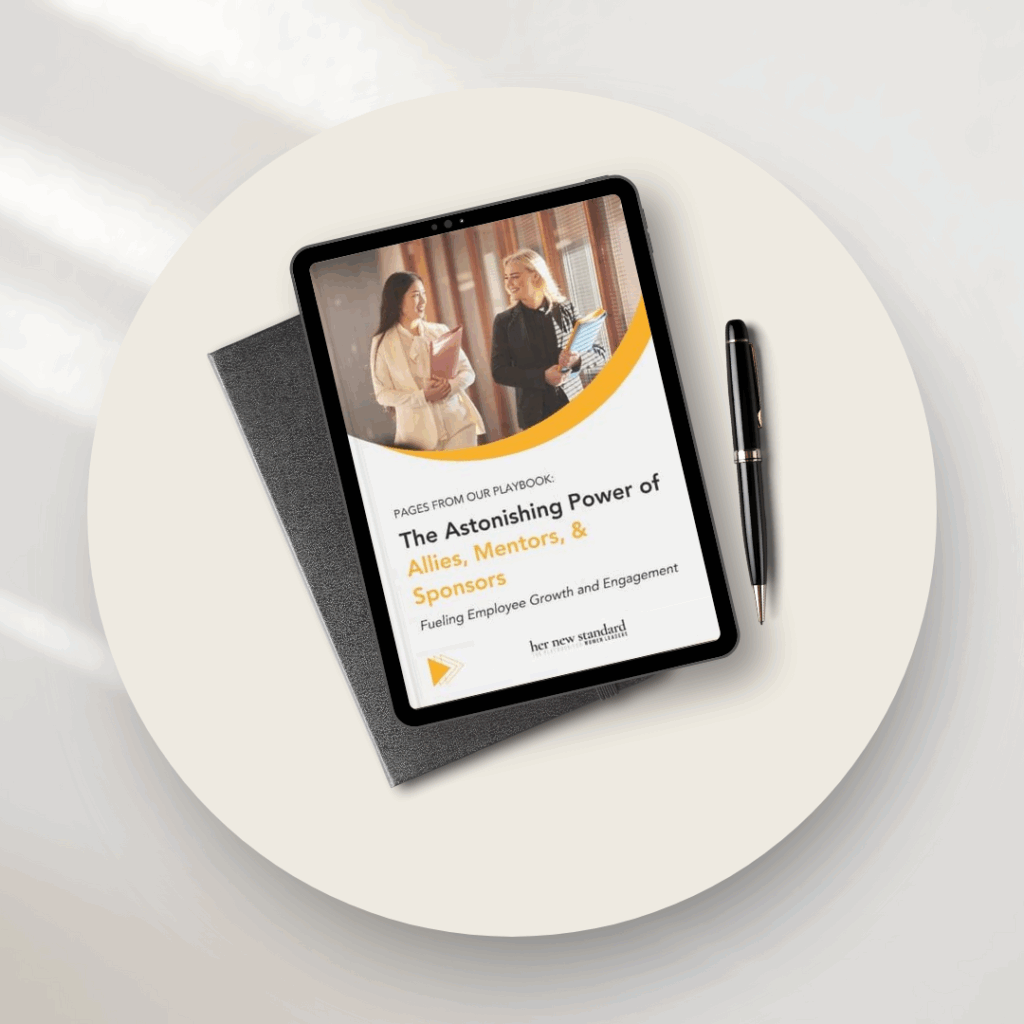Women outnumber men at almost every educational level and hold over half of all professional-level jobs, yet they make up only 24% of senior management roles and a mere 3% of Fortune 500 CEOs. Despite all the focus this issue has received in recent years, the pace of change has continued to be agonizingly slow. What’s getting in the way?
One major culprit is the similarity bias. We all gravitate towards those who share common characteristics with us such as gender or race. This means that, in a world where white men hold the overwhelming majority of executive positions, women – especially women of color – often become locked out of critical networks, have fewer meaningful interactions with senior leaders and are repeatedly overlooked for high-stakes assignments.
This bias not only hurts women but also business outcomes. Fortune 500 companies with the highest representation of women on their boards financially outperform those with the fewest. Additionally, according to HBR, “Gender balance in companies and on teams improves a host of outcomes including financial results, innovation, decision making, organizational commitment, retention and job satisfaction.”
Overcoming years of bias that have kept women and minorities from equal representation in top leadership positions requires intentional intervention by organizations. One tool that has proven to be extremely effective, when implemented well, is sponsorship.
What is Sponsorship?
Many people confuse sponsorship with mentorship. A mentor is someone who is willing to use their knowledge and experience to provide support and guidance to their mentee. They listen to their mentee’s career vision, offer feedback, and give advice. While a mentor may also be a sponsor, there is a critical difference between the two. Sponsors are senior-level executives who use their position and power to advance a more junior person’s career. While a mentor’s role may be passive, a sponsor’s role is anything but.
A sponsor has the power to open doors for their protege in important ways, including:
- Increasing visibility. A sponsor shares the accomplishments of their protege with other senior leaders and openly advocates for them in closed-door meetings. This is particularly critical in talent management meetings where important assignments and promotions are discussed.
- Sharing valuable insight. Sponsors use their unique perspective on the company to help their proteges identify and make strategic contributions that will increase their value to the organization and help them get noticed. Sponsors also provide valuable help in navigating organizational politics.
- Making meaningful introductions. Sponsors connect their proteges to influential and powerful people within their organization or industry who can help them advance.
- Candid Feedback. Sponsors can provide candid feedback to their proteges about their reputation in the organization and how they stack up against criteria for leadership.
How Sponsorship Helps Women Leaders (and Organizations) Succeed
According to Catalyst, women start out behind men in the talent pipeline and tend to remain there even with mentoring. However, when women have sponsors, they’re just as likely as men to be promoted.
Sponsorship becomes even more important for women seeking to make it to the executive level. While women in more junior roles may progress by doing exceptional work, as they move up the ladder and the number of next-level spots decreases, having someone with a seat at the decision-making table to actively advocate on their behalf is critical.
Sponsorship also benefits the overall organization. At HNS, we find that when we help women connect to senior leaders in their organizations during our Accelerate program, they get reassurance that they are valued and have opportunities for growth. As a result, they tend to stay with the organization.
Sponsorship has even greater advantages, given it’s longer-term focus. Catalyst research found that sponsorship programs resulted in more effective leaders and teams, as well as increased job satisfaction, commitment to the organization and desire to stay with the organization. They also strengthen the talent pipeline, bolster engagement, and improve company culture.
In our recent Women’s Leadership Development Roundtable, Stephanie LeBlanc, Global Head of Inclusion for Women of Color at Google, joined HNS to discuss how organizations can advance women leaders through sponsorship. As a result of this discussion, we’re delighted to share six keys to implementing a successful sponsorship program at your company.
Begin By Evaluating Your Company’s Current Talent Development Strategy
Before you begin your sponsorship program, step back and take a look at your organization’s overall talent strategy and the results you’ve achieved so far. What is working in terms of women’s advancement and where is it stalling? How could sponsorship fit into your overall strategy and who would benefit most? Typically, mentoring is great for those in entry or mid-level positions who are still building a track record of success, while sponsorship is a stronger path to advancement for those with potential for senior-level roles. It’s a good idea to offer varying levels of support and to ensure that each of these efforts is part of a cohesive strategy.
We love the example set by Deutsche Bank’s Accomplished Top Leaders Advancement Strategy (ATLAS) sponsorship program:
“ATLAS prepares a diverse group of high-performing women for executive leadership positions by pairing them with a member of Deutsche Bank’s Group Executive Committee from a different business line. These women are already leaders at the firm who have the potential to move even higher up the ranks and are selected via a rigorous nomination process. The ATLAS women are then assigned as informal mentors to women in more junior level Managing Director positions. This strategic alignment between executive leadership sponsoring and informal mentoring at the management level underscores the firm’s commitment to women’s leadership and employee development… Across the entire ATLAS cohort group, 45 percent of women participating are now in new or expanded roles.” [1]
When planning your sponsorship program, ask yourself:
- Does your company have protocols in place to identify high potential women?
- What programs do you currently offer to nurture rising talent?
- How can you use your sponsorship program as part of an overall strategy to develop and nurture a diverse, high-performing talent pipeline?
Set Clear Expectations
According to HBR, “when women are mentored by men, they make more money, get more promotions and have better career outcomes – not because men are better mentors but because they have more power.”
However, research from the Center for Talent Innovation found that 71% of sponsors have proteges whose gender and race match their own. This is an example of the similarity bias at work. Due to this phenomenon, we recommend an intentional approach to pairing sponsors and proteges, to avoid perpetuating the status quo and to ensure that those who need support the most are not excluded. This is particularly important with women of color, who tend to have an even harder time forging alliances with senior management.
When engaging senior leaders as sponsors, clearly state expectations, define how you will measure success and include sponsors in talent management discussions. For many executives, knowing that they’ll be held accountable for their role in advancing women will strengthen their commitment to being powerful advocates.
Show Executives What’s In It For Them
To help build the commitment of senior leaders, communicate that this is an investment with worthwhile returns not only for their proteges, but also for themselves.
By participating, sponsors gain insight into different levels of the business that they may not observe on a day-to-day basis, receive valuable feedback and are exposed to diverse perspectives, all of which allow them to lead more effectively and strategically. Additionally, successful sponsors are more highly regarded within their organization due to their demonstrated commitment to recognizing and developing talent.
Combat Unconscious Bias Through Education
Whether or not we’re consciously aware of it, we all hold biases that lead to assumptions, and sometimes these assumptions result in missed opportunities for high-potentials. For example, one of our clients was routinely bringing up whether women had children when they were mentioned for opportunities. It’s no surprise that this information, totally unrelated to their ability to do the job, had a negative effect on women getting promoted. Decision makers in general, and sponsors in particular, need to become aware of their biases so that they can actively fight against them. No sponsorship program will be successful if those at the top have unexamined and unfair assumptions that get in the way of women’s advancement.
Give Everyone a Voice in the Match-Making Process
The foundation of a successful sponsorship is trust. Many sponsorship programs fail because senior leaders feel like they are being forced to put their reputation on the line to vouch for someone who they don’t know well or fully believe in. Proteges must also trust that their sponsors have their best interests in mind and are truly invested in their success.
It’s best to focus on sponsoring women who have been identified as high potential, so make sure your organization has a bias-free process to identify who has the ability to move up. While it takes time and experience to build trust, a proven track record of success will help establish the protege’s credibility with their sponsor from the start. Then create opportunities for these high-potential women to interact with senior executives so they can begin to build relationships and identify who they’d most like to work with.
To ensure the best pairings, ask both sponsors and proteges about their goals and preferences, as well as who they’d ideally like to work with. As we found out during our roundtable discussion, Google has had success involving managers in the pairing process. Since managers oversee these rising women day-to-day, they know them better than most and also have more familiarity with executives, so their input can be invaluable.
The strongest relationships are typically voluntary. By involving sponsors, managers and high potential women in the match-making process, you greatly increase the odds of a successful sponsorship.
Provide Sponsors and Proteges With a Framework for Success
As an organization, your role doesn’t end once the pairing is done. It’s your responsibility to equip both sponsors and proteges with the tools and resources they need to excel in their roles.
Don’t assume that sponsors know how to approach their role just because they are executives. Senior leaders already have a lot on their plate and may feel like they don’t have the extra resources to dedicate to navigating this new relationship… So make it easy for them! Provide tools and coaching to educate the sponsor on how to be effective in their role.
Similarly, proteges need to be equipped with the right skills and resources to make the most of their relationship with their sponsor. Many successful sponsorship programs include training for proteges to set expectations and fill any skill gaps. Programs like our virtual women’s leadership intensive Fast Track can be a great addition to equip proteges to get the most from the experience.
Not sure where to start? The Center for Creative Leadership offers a free guide to support sponsors and proteges in navigating their relationship here.
Sponsorship is high stakes for all involved but the benefits far outweigh the challenges. By bringing intention to your organization’s approach to sponsorship, you can accelerate the advancement of underrepresented leaders and create a more diverse and inclusive workplace. The research is evident – we’ll all be better for it.
Source
[1] https://www.catalyst.org/research/sponsoring-women-to-success/

Unlock the Power of Allies, Mentors & Sponsors
Explore proven strategies from our playbook on how to build meaningful relationships that fuel professional growth, boost engagement, and accelerate advancement — especially for women leaders.This 30+ page eBook is packed with actionable insights you can start applying today.
(No email required)
Enjoyed this post? You might also like…




